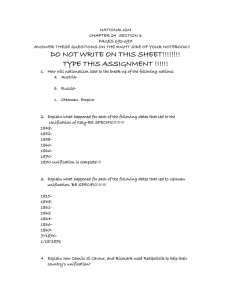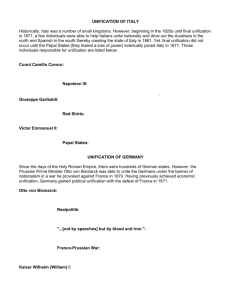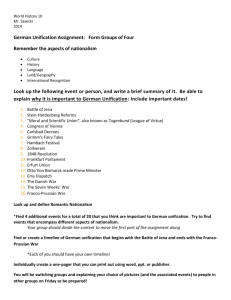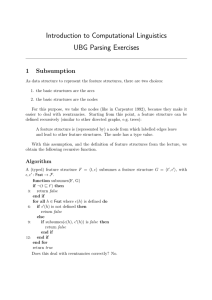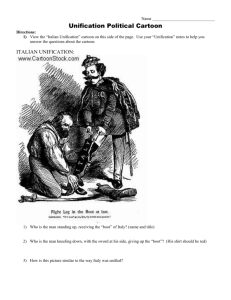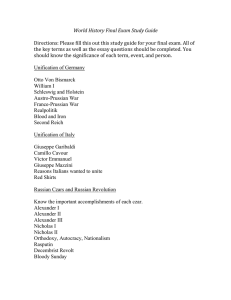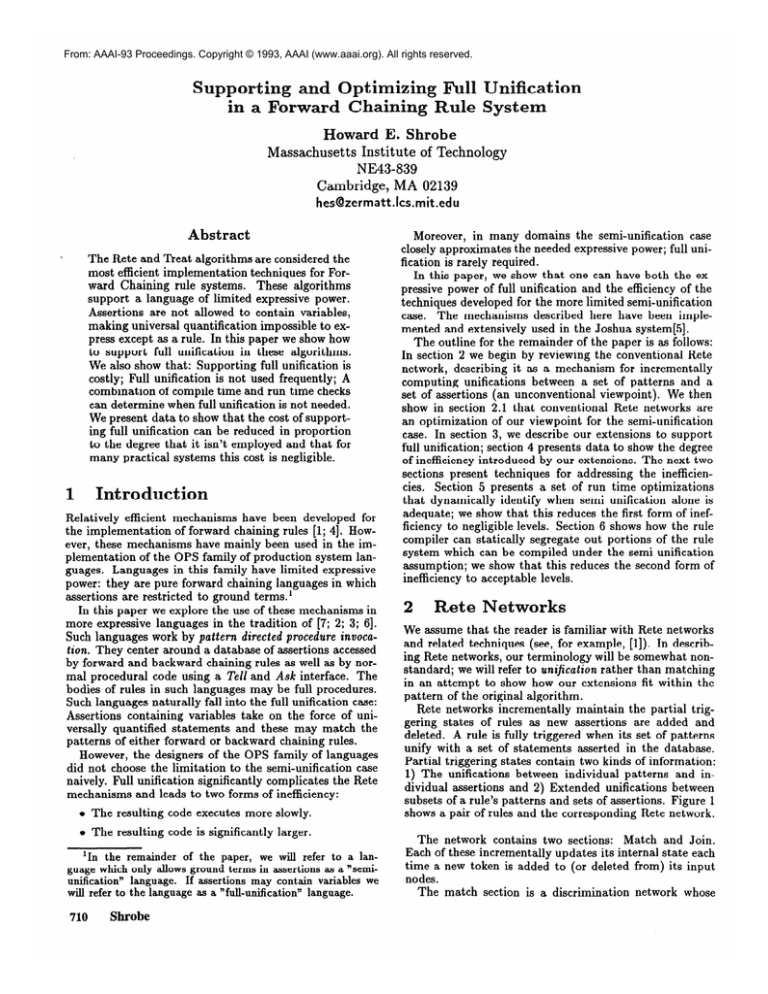
From: AAAI-93 Proceedings. Copyright © 1993, AAAI (www.aaai.org). All rights reserved.
Supporting and Optimizing Full Unification
in a Forward Chaining Rule System
Howard E. Shrobe
Massachusetts Institute of Technology
NE43-839
Cambridge, MA 02139
hes@zermatt.lcs.mit.edu
Abstract
The Rete and Treat algorithms are considered the
most efficient implementation techniques for Forward Chaining rule systems. These algorithms
support a language of limited expressive power.
Assertions are not allowed to contain variables,
making universal quantification impossible to express except as a rule. In this paper we show how
to support full unification in these algorithms.
We also show that: Supporting full unification is
costly; Full unification is not used frequently; A
combination of compile time and run time checks
can determine when full unification is not needed.
We present data to show that the cost of supporting full unification can be reduced in proportion
to the degree that it isn’t employed and that for
many practical systems this cost is negligible.
1
Introduction
Relatively efficient mechanisms have been developed for
the implementation of forward chaining rules [l; 41. However, these mechanisms have mainly been used in the implementation of the OPS family of production system languages. Languages in this family have limited expressive
power: they are pure forward chaining languages in which
assertions are restricted to ground terms.’
In this paper we explore the use of these mechanisms in
more expressive languages in the tradition of [7; 2; 3; 61.
Such languages work by pattern directed procedure invocation. They center around a database of assertions accessed
by forward and backward chaining rules as well as by normal procedural code using a Tell and Ask interface. The
bodies of rules in such languages may be full procedures.
Such languages naturally fall into the full unification case:
Assertions containing variables take on the force of universally quantified statements and these may match the
patterns of either forward or backward chaining rules.
However, the designers of the OPS family of languages
did not choose the limitation to the semi-unification case
naively. Full unification significantly complicates the Rete
mechanisms and leads to two forms of inefficiency:
o The resulting code executes more slowly.
o The resulting code is significantly larger.
the remainder of the paper, we will refer to a language which only allows ground terms in assertions as a “semiunification* language. If assertions may contain variables we
will refer to the language as a “full-unification” language.
‘In
710
Shrobe
Moreover, in many domains the semi-unification case
closely approximates the needed expressive power; full unification is rarely required.
In this paper, we show that one can have both the expressive power of full unification and the efficiency of the
techniques developed for the more limited semi-unification
case. The mechanisms described here have been implemented and extensively used in the Joshua system[5].
The outline for the remainder of the paper is as follows:
In section 2 we begin by reviewing the conventional Rete
network, describing it as a mechanism for incrementally
computing unifications between a set of patterns and a
set of assertions (an unconventional viewpoint). We then
show in section 2.1 that conventional Rete networks are
an optimization of our viewpoint for the semi-unification
case. In section 3, we describe our extensions to support
full unification; section 4 presents data to show the degree
of inefficiency introduced by our extensions. The next two
sections present techniques for addressing the inefficiencies. Section 5 presents a set of run time optimizations
that dynamically identify when semi unification alone is
adequate; we show that this reduces the first form of inefficiency to negligible levels. Section 6 shows how the rule
compiler can statically segregate out portions of the rule
system which can be compiled under the semi unification
assumption; we show that this reduces the second form of
inefficiency to acceptable levels.
2
Rete Networks
We assume that the reader is familiar with Rete networks
and related techniques (see, for example, [l]). In describing Rete networks, our terminology will be somewhat nonstandard; we will refer to unification rather than matching
in an attempt to show how our extensions fit within the
pattern of the original algorithm.
Rete networks incrementally maintain the partial triggering states of rules as new assertions are added and
deleted. A rule is fully triggered when its set of patterns
unify with a set of statements asserted in the database.
Partial triggering states contain two kinds of information:
I) The unifications between individual patterns and individual assertions and 2) Extended unifications between
subsets of a rule’s patterns and sets of assertions. Figure 1
shows a pair of rules and the corresponding Rete network.
The network contains two sections: Match and Join.
Each of these incrementally updates its internal state each
time a new token is added to (or deleted from) its input
nodes.
The match section is a discrimination network whose
Figure 1: A Typical Rete Network
terminal nodes (the match nodes) compute unifications between rule patterns and assertions in the database. State is
stored only at the match nodes (these are the alpha memories of [l]). Patterns from different rules which, are variants (i.e. identical up to variable renaming) share match
nodes; two patterns which share leading terms share a path
through the network up to the point of divergence. The
tests made by the nodes above the match nodes filter out
assertions which cannot possibly unify with the pattern of
the match nodes below them.
The Join network begins at the Match nodes. State is
stored at all join nodes (these are the beta memories in the
terminology of El]). E ac h node of the join section merges
the partial unifications represented by its two parent nodes,
checking that the shared variables are unifiable. Each terminal node of the join network corresponds to a complete
set of rule patterns. If two rules share leading patterns,
they share join nodes up to the point of divergence.
The rete network compiler emits code for each node in
the network to perform the above functions.2The code for
match and join nodes perform the indicated unifications;
they also package up the results into state tokens stored at
the node.3
2.1
assertion which match different occurrences of the same
variable are equal.
When assertions contain only ground terms the discrimination nodes perform part of the unification by testing for
equality between constants in the pattern and constants in
the assertion. Therefore, the code at a match.node may
omit these tests.
Similarly, the tests at the join nodes can be reduced to
checking that variables shared between the parents of the
join are bound to equal values. Hashing (or other forms
of indexing) may be used to speed up the join computation. Each parent of a join node maintains a hash-table of
tokens; the key for this table is a list of the values of the
shared variables.
In the semi-unification case, a hash probe will find the
precise set of unifiable tokens; therefore, no other code is
needed at the join nodes.
Finally, in the semi-unification case, the state tokens
need not contain a variable binding environment; each variable can be identified with a particular term from one of
the mat thing assertions.
These optimizations are not fully available in the fullunification case.
We have described the Rete algorithm in a very general
context, that of computing and extending unifications.
The semi-unification case allows a variety of optimizations
to be made by replacing unification with equality tests.
To extend the traditional Rete algorithm to support the
full-unification case we must undo these optimizations, replacing equality checks by unifications.
The following questions must be addressed:
How are logic variables represented?
What code is compiled
mat thing?
21nthe Joshua system, the methods for generating this code
are customizable
by the user; this is part of the Protocol of
Inference see [5].
3 Joshua aho w s user-supplied procedural condition elements;
these require a special node type.
Procedural
nodes are attached to a single parent node; they contain the original procedure surrounded by supporting code which generates a new
token each time the procedure “succeeds”.
For brevity, we will
not further discuss these condition elements.
the unification
Row are state-tokens represented and computed?
Optimizations for the Semi
Unification Case
In classic Rete networks all assertions contain only ground
terms and therefore no variable in a rule’s pattern may
ever be bound to another variable. Under these conditions
the Rete network can be viewed as computing relational
selects (at the match nodes) and relational joins (at the
join nodes) (as pointed out in [4]).
Operationally matching reduces to: 1) checking that
constants in the assertion are equal to corresponding constants in the pattern and 2) checking that terms of an
to conduct
How do auxiliary indices (e.g.
nodes) handle logic variables?
hash-tables
at join
Having made these choices we will then need to see what
impact they have on the components of the Rete network.
3.1
3. I. I
ata Structures and
Operations
asic
Represent at ion of Logic Variables
We adopt a representation for logic variables based on
the Prolog oriented techniques of the Warren Abstract Ma
chine [8].
Logic variables are represented as pointers to their values; an unbound logic variable points to itself. An unbound
logic variable is unified with a value by making it to point
to the value; this value might be another unbound logicvariable
which might
later
be bound
to a value,
leading
to
a chain of logic-variable pointers as shown in figure 3.
To find the value of a logic variable one must follow the
chain of pointers until encountering either a value which
is not a logic variable or a logic variable which points to
Rde-Based
Reasoning
711
(lambda
(assertion)
(with-unification
(with-unbound-logic-variables
(?x)
(unify
‘P (dcreference
(pop assertion)))
(unify
?x (dcreference
(pop assertion)))
(unify
‘a (dereferencc
(pop assertion)))
(unify
(dereference
TX) (dereference
(pop assertion)))
(unify
‘b (dereference
(pop assertion)))
. . . code to be executed
upon success
. ..)))
Figure 2: Full Unification
?x b]
Code Corresponding
rp 7x
Implementation
11
[P (?a
Conwcal
. ?b)
?a
?b
?bI
Unifier
[P (1 . 1) 1 1 11
Subotrtutxcma
?A -1
?B -1
to [P ?x a
of Unification
o If neither argument is a logic-variable, then UNIFY
succeeds if the arguments are EQUAL and otherwise
fails.
o If exactly one argument is a logic-variable, UNIFY
succeeds, the logic-variable is bound to the other argument and a trail entry is made.4
o If both arguments are logic-variables then one is
bound to the other a trail entry is made and UNIFY
succeeds.
(If both logic-variables are stored on the
stack, then the one pushed more recently must point
to the one more deeply nested).
*The unification is only allowed if the variable does not occur
within the structure of the other arguments.
Prolog implementations typically skip this “free-for” check for efficiency as do
we in our implementation.
Shrobe
w
Unifyxng
The match compiler is responsible for emitting the unification code corresponding to a pattern. When given an
assertion to match, the code must fair if the pattern and
the assertion are not unifiable; otherwise it must succeed
and bind the logic-variables of the pattern to the values
implied by the unification.
Figure 2 shows the code emitted for the pattern [P ?x a
?x b].
In this code, With-unification establishes a unification
context (i.e. it notes the level of the trail on entry and
unwinds the trail to that level upon exit. Also it establishes
a catch tag which is thrown to in the event of failure. Withunbound-l&k-variables
creates a set of new logic-variables
(typically these are stack allocated). Notice that each term
of the assertion must be dereferenced before the call to
Unify since the term might be a logic variable.
Unify is called with atomic elements (including logic
variables) as the first argument; when the pattern contains
compound terms, the match compiler must recurse into the
substructure of these terms. For simplicity of presentation
we omit the details, see [8]. The behavior of Unify is as
follows:
712
w
Most
itself. This operation is referred to as dereferencing.
A
logic variable must be dereferenced before its use.
When a logic variable is bound, an entry consisting of the
logic variable is made on a stack called the trail. Before a
pattern matching operation is begun, the level of the trail is
saved. To return to the binding state which obtained at the
beginning of the operation (e.g. when the unification fails)
each logic variable above the marked point on the trail is
reset to point to itself and the trail level is reset to the
marked point. This operation is usually called unwinding
the trail, or untrailing.
3.1.2
Aoorrtzon:
Pattern:
Figure 3: A Unification and its Implementation
Level View
Failing is accomplished by throwing the value NIL to a
catch-tag for FAIL. This is normally established by withunification; this causes the trail to be unwound.5
3.1.3
Saving the Binding
State in Tokens
The code emitted by the Rete network compiler for a
match node tests whether the triggering assertion can be
unified with the rule pattern; if so it produces a state-token
containing the bindings of the pattern’s logic variables.
Consider the unification shown in figure 3. The variable ?x of the rule’s pattern is unified with the list (?a .
?b) of the assertion; this list contains variables which are
bound to ground terms (e.g. 1). The value of ?x is valid,
therefore, only as long as ?a and ?b continue to be bound
to 1. However, ?a and ?b are contained in a database
assertion whose intent is to state a universal quantification. Therefore, the binding of ?a and ?b must be untrailed
and the values of their current bindings must be preserved
elsewhere.6 Notice that this is quite a bit more expensive than the semi-unification case where the assertion can
serve as an adequate representation of the binding state as
explained in 2.1.
To preserve the volatile binding state over a longer
duration, state-tokens maintain an environment of logicvariable values with a slot for each variable in the pattern.
Each slot is filled with the unified-value of its corresponding logic-variable. The unified value of a logic-variable is
computed as follows:
o The logic-variable
is dereferenced.
o If the variable is unbound, its unified value is a new
logic-variable. All occurrence of a particular unbound
logic-variable have the same new logic-variable as their
unified-value.?
51n the implemen tations of Joshua on Symbolics equipment,
Dereference is a microcoded instruction.
In implementations
on
more conventional machines it would be implemented either as
subroutines or an inline code fragment; either approach is both
slower and consumes more instructions.
Our measurements are
made on Symbolics equipment, yielding more favorable results
for the full-unification case than would result on more conventional machines.
61.e. our implementation
uses a shallow binding scheme for
logic variables but needs to preserve their values beyond the
dynamic extent.
‘Unbound logic-variables
are replaced by new variables to
~iri& i.ubound and the bound value is atomic,
trtrilictd-value is the bound-value.
o II’t.h(*i)c)utld value is a compound data-structure, then
tlrr. sub-slructure is traversed replacing each term by
its trnilicadvalue.
111t.hctcaxsmple of figure 3 the logic-variable ?x is bound
to the pair (?a . ?b). But ?a is bound to ?b which is in
turn bound to 1; so the unified value of ?x is (1 . l), a
value which persists even after unwinding the trail.
3.2
3.2.1
Extending
the Algorithm
The Discrimination
Network
We begin with the discrimination nodes of the Match
network. Each discrimination node dispatches on the value
of a term in the assertion, see figurel. For large branching
factors, a hash table is an appropriate implementation. If
the term being dispatched on is a constant then it serves as
the hash-key. The value retrieved is the next discrimination node to visit. If there is a branch for the key *variable*
(indicating a rule pattern with a variable at this position),
this must also be followed.
Notice that the term being discriminated on may itself
be a logic-variable. In this case all outgoing branches must
be followed, since a variable can match anything.s
3.2.2
The Match
Nodes
The discrimination network search discards most match
nodes that don’t unify with the assertion; however, some
non-unifiable match nodes may still be reached. For example:
Rule Pattern:
Assertion:
(P
(P
a
?x
?x ?y ?z) environment
?Y ?z ?w) environment
(lambda
(token-l
(with-unification
;; unify ?y from
(unify
(token-slot
;; unify ?z from
(unify
(token-slot
(let ((new-token
;; copy ?x
(setf (token-slot
;; COPY ?Y
(setf (token-slot
;; copy ?z
(setf (token-slot
;; copy ?w
(setf (token-slot
new-token)))
The Join Nodes
Join nodes are extended in a similar manner. The rule
compiler generates a map for each join node specifying
prevent sharing of logic-variables held in state tokens with those
in assertions (or other state-tokens).
Were this not done, the
unifications performed at join nodes would unintentionally bind
the variables in the assertions. Resolution systems rename variables in the resolvent for the same reason.
‘We do not a tt e m p t to carry along the variable bindings
while traversing the discrimination
network.
?x ?y -
1 ?y 1 ?z -
2 ?z -L 3
2 ?w - 3
token-2)
1 with ?y from 2
token-l
2) (token-slot
token-2
1))
1 with ?z from 2
token-l
3) (token-slot
token-2
2))
(make-new-token
:n-variables
3)))
new-token
1) (copy-unified-value
(token-slot
token-l
1)))
new-token
2) (copy-unified-value
(token-slot
token-l
2)))
new-token
3) (copy-unified-value
(token-slot
token-l
3)))
new-token
4) (copy-unified-value
(token-slot
token-2
3)))
Figure 4: Join Code for The F’ull Unification Case
which variables from the two parent nodes are to be unified. The compiler emits code to perform these unifications
and to copy the unified values of all the variables into a new
state-token. Figure 4 shows a join to be performed and the
corresponding code generated by the rule compiler.
Many Rete network implementations use hashing (or
other indexing) to speed up the join computation, as explained in section 2.1. In the full unification case, any of
the shared variables in either token might be an unbound
logic-variable. Unlike ground terms, two distinct logic variables might match; a list of the values of the shared variables is, therefore, not an adequate retrieval key. A simple
extension which solves this problem is as follows:
e When storing a new token in a node:
- If any of the shared variables are unbound, then
hash the token under a special key: *unboundvariable *.
?c
b ?c)
c ?x
c)
The discrimination network treats each occurrence of ?x
in the assertion as independent, allowing this assertion to
reach the match node although it isn’t unifiable with the
pattern. Notice that the inconsistency between the assertion and the pattern occurs at constant terms in the pattern. As mentioned in section 2.1, this can never happen
in the semi unification case and the match code need only
check the positions corresponding to variables.
In contrast, the full unification match code must perform the entire unification as explained in section 3.1.2
(i.e. tests must be generated for both constant and variable positions). It must also save the results in a binding
vector by copying out the unified values, as explained in
section3.1.3.
The match compiler, therefore, emits code
containing two sections: The first conducts the unifications, the second creates the binding vector and fill it with
the unified values of the logic variables.
3.2.3
l’s
-
Otherwise
ues as the
the list of the shared variable val-
When looking for stored tokens to’join with a new
token:
3.2.4
-
If any of the new token’s shared variables are unbound then look at every token stored in the other
parent node.
-
Otherwise form a key which is the list of shared
variables and attempt to join with every stored
token hashed in the other parent node under this
key. Also attempt to join with every token hashed
under the key *unbound-variable*.
Compiling
Rule Bodies
Forward rule bodies may contain normal procedural
code which references the logic variables of the patterns. In
the full unification case, variables referenced in the body
of a rule may be left unbound by the matching process;
they therefore must be treated as logic variables and be
dereferenced before being used.
The values of the logic-variables are stored in the environment of the triggering state token. The rule compiler,
therefore, first emits a prologue which fetches the variable
values from the environment into local variables. The rest
of the rule body’code is transformed so that every reference
to a logic-variable is wrapped within a call to dereference.
Rule-Based Reasoning
713
example
Natural
Deduction
Troubleshooting
Cryptarithmetic
Planning
Time in
Semi
14,114
79,353
851,288
209,308
ReteNetwork
F 11
84,7u25
346,726
2,872,276
739,605
Total Run Time
Semi
Full
167,816
360,740
645,634
943,602
3,489,086
7,309,309
891,742
1,413,495
Table 1: Run Times of Full and Semi Unification Code
4
Full Unification
Costly
Support
is
These extensions lead to semantically correct behavior in
the full unification case. However, as can also be seen, each
extension removes a constraint of the semi-unification case
which was used in optimizing the original algorithm.
Table 1 shows the relative performance of the matching and merging portions of a a number of demonstration
systems. Table 2 shows the relative sizes of the generated
code for a variety of systems.
The following are among the causes of this difference:
0 Equality tests in the match and join code are replaced
by unification.
e The discrimination network in the match network acts
only as a partial filter in the full unification case (due
to the possibility of logic-variables in the assertions,
see section 3.2.1). The match code generator cannot
assume that every constant has already been checked
and must generate checks for the constants as well as
the variables.
e Hashing alone is a sufficient join test in the semiunification case. In the full-unification case this is
not true. A rather bulky merge procedure must be
still be generated and called, see section 3.2.3.
e The code generated for rule bodies must replace variable references by calls to dereference.
This incurs
both increased code size and slower performance.
e In the semi-unification case, state tokens need not contain environments. In the full unification case environments must be built and values copied between them.
e Calls to copy-unified-vahe must be used to copy logicvariable values to new state tokens. If variables are
bound to compound data-structures this incurs the
cost of traversing and incrementally rebuilding those
sub-structures containing logic-variables.
e In the semi-unification case, match procedures typically check only the terms corresponding to variables in the pattern; constants in the pattern are ignored since the discrimination nodes check them. This
means that two match nodes which have the same
pattern of variable occurrences but distinct constants
may nevertheless share match procedures. This is not
the case for the full unification case, only variant patterns may share match procedures.
5
ynamic
Optimizations
The programming style of typical knowledge based systems infrequently employs the full unification case. Unfortunately, the expressiveness of the full unification case
leads to code with much worse run-time performance.
714
Shrobe
This section addresses one approach to this problem:
optimizations performed at run-time.
We have extended the rete network compiler to generate two sets of procedures for each of the match and join
nodes. The first of these is the less efficient but more general code capable of handling the full unification case; the
second procedure handles only the semi-unification case,
but is considerably more efficient. The rete network interpreter is responsible for dispatching to the semi-unification
procedure if allowable, otherwise it must call the full unification procedure.
To make this decision, our system checks each newly
created assertion for the presence of logic-variables and
stores the result in the data-structure representing the assertion. (The check must be made in any event, since all
logic-variables in a database assertion must be copied so
as to be unique to that assertion). At a match node, the
rete interpreter uses this information to determine which
procedure to call.
When a new state-token is created, a we check whether
any element of the environment is an unbound logic variable; the token is marked with the result of this check. At
a join node the semi-unification code is called if both input
tokens are marked as logic-variable free. Notice that only
the full unification procedures need to check for the presence of unbound logic-variables in the output token since
in the semi unification case the output will necessarily contain only ground terms.
The crucial question for a dynamic optimization
is
whether the cost of detecting the opportunity swamps out
the resulting benefit. In this case, the detection cost is
that incurred in checking assertions for non-ground terms
and (if we’re running a full-unification procedure) the cost
of a similar check on any newly generated token. Metering
indicates that this consumes about 1.5% of total run time.
To test the efficacy of dynamic optimization, we ran
a rule-based natural deduction system on three versions
of the same problem. The first version uses only ground
terms, the second has a mix of ground terms and terms
with variables and the third version is completely quantified. In the first case, all matches and joins used the
semi-unification code and ran the problem 6.9 times faster
than would the full-unification code. In the second case,
86% of the matches and 59% of the joins used the semiunification code with a resulting speedup of 2.4. In the
last case, of course, all matches and joins used the fullunification code. These results show that the system is
highly effective in dynamically identifying when the semi
unification code can be utilized.
pt imizat ions
The dynamic optimizations incur the additional cost of
generating two procedures at each node. A traditional production system would generate only the semi unification
code; but our system also generates code to support the
rarer case of full unification. As table 2 indicates this code
is considerably larger. Furthermore, we generate only a
single version of the code for rule bodies which is required
to be the slower and bulkier code capable of handling full
unification.
In this section, we discuss how we use information avail-
example
Rllle
Circuits
Cryptarithmetic
Midsummer
Discrete Event
Ht Atms
Ht Ltms
NatDed
All Rules
10
59
7
7
7
15
7
123
Matchers
Size
2
37
7
188
3
56
4
81
4
82
5
120
6
266
36
950
Semi Unification
Mergers
ProcSize
edures
0
2
44
34
979
307
46
3
68
20
4
94
64
3
66
80
6
146
4
109
0
50
1380
587
Rule
Body
212
2251
124
237
153
391
425
4009
Full Unification
Mergers
ProcSize
edures
2
260
0
34
6816
628
3
372
73
4
544
36
3
390
120
6
849
169
4
672
0
50
9186
1102
Matchers
Size
7
364
14
703
6
264
7
361
8
412
15
754
8
508
74
3797
RUIC
Body
214
2269
124
237
153
397
425
4035
Table 2: Compiled Code Size of Full and Semi Unification Code
able at compile time to help the rule compiler determine
which nodes of the network (as well as which rule bodies)
will never encounter the full-unification case. This lets us
generate only the more efficient semi unification code at
any node or rule body so classified.
In the Joshua system, all operations of the system (including the operations of the rule compiler) are driven by
the class of the assertion (or pattern) being processed. The
classes are identified with the predicate of the assertion and
are, in fact, CLOS classes; see [5] for details. The data
structures used to represent rule patterns and data-base
assertions are instances of these CLOS classes.
One such predicate class (which can be “mixed in” to
any other assertion class) is no-variables-in-data-mixin.
If one tries to enter an assertion of this type into the
database, an error is signalled. Rule patterns which are instances of this class can therefore reliably assume that any
triggering assertion will contain only ground terms. This
information is used at rule compilation time to determine
that a match node will be “semi unification only”. A join
node whose parent nodes are both “semi unification only”
will also be “semi unification only”. If a terminal node of
the rete network is “semi unification only” then all rule
bodies connected to that node are also “semi unification
only” . ’
Table 2 shows the relative sizes of the full-unification
and semi-unification code for 7 systems. In aggregate the
full unification matchers are 4 times larger than the semiunification matchers; the full unification mergers are 6.7
times larger. With static optimizations applied, our system generates no full unification code for most of the systems (this is optimum, these systems never use the full
unification capability).
The system is forced to generate
both versions of the code for the one subsystem which does
take advantage of the full unification. In aggregate, this
save 86% of the matching code and 92% of the merging
code.
7
frequently the case. The system’s performance gracefully
degrades as universally quantified assertions are entered in
the database.
Also we have shown that when extra information is conveyed to the system at compile time, we can avoid generating the bulkier code for the general case. Furthermore, we
have indicated that in many practical cases, this a priori
information is obtainable.
eferences
PI C.
Forgy. Rete: A fast algorithm for the many pattern/many object pattern match problem.
Ar-tificiul
Intelligence, 19117-38, 1982.
PI
PI G.J.
McDermott, D.V.and Sussman. The conniver reference manual. Technical Report Memo 259, MIT Artificial Intelligence Laboratory, 1972.
PI
TREAT:
A New and Eficient
Daniel P. Miranker.
Match Algorithm for AI Production Systems. Morgan
Kaufmann, San Mateo, California, 1990.
PI
S. Rowley, H. Shrobe, R. Cassels, and W. Hamscher.
Joshua: Uniform access to heterogeneous knowledge
structures (or why joshing is better than conniving or
planning). In National Conference on Artificial Intelligence, pages 48-52. AAAI, 1987.
bl
G.J. Sussman and D.V. McDermott.
Why conniving
is better than planning. Technical Report AI Memo
255A, MIT Artificial Intelligence Laboratory, Cambridge Mass., 1972.
VI G.J.
Sussman, T. Winograd, and E. Charniak. The
micro-planner reference manual.
Technical Report
AI Memo 203, MIT Artificial Intelligence Laboratory,
Cambridge, MA, 1970.
iscussion
We have shown that the expressiveness of full unification
can be supported with very limited cost in efficiency. This
result depends on the statistics of assertion usage: most assertions contain only ground terms. This allows us to generate optimized procedures for the semi unification case. If
the triggering assertions all contain only ground terms then
the more efficient semi unification case is called; this is very
C.E. Hewitt. Description and theoretical analysis (using schemata) of planner: A language for proving theorems and manipulating models in a robot. Technical
Report AI-TR-258, MIT Artificial Intelligence Laboratory, 1972.
PI
D.H.D Warren.
An abstract prolog instruction set.
Technical Report SRI Technical Note 309, SRI International, October 1983.
‘Our system also supports user supplied procedural condition elements. If such a node’s parent is semi-unification only
and it introduces no new logic variables, then the node itself is
semi-unification only.
Rule-Based Reasoning
715

